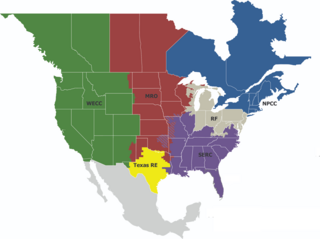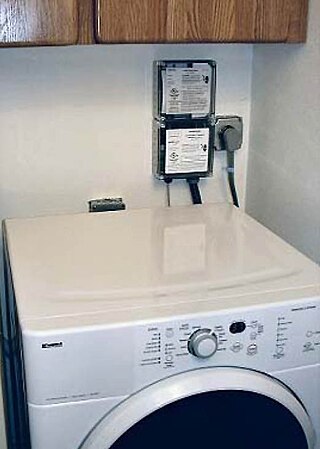
The North American Electric Reliability Corporation (NERC) is a nonprofit corporation based in Atlanta, Georgia, and formed on March 28, 2006, as the successor to the North American Electric Reliability Council. The original NERC was formed on June 1, 1968, by the electric utility industry to promote the reliability and adequacy of bulk power transmission in the electric utility systems of North America. NERC's mission states that it "is to assure the effective and efficient reduction of risks to the reliability and security of the grid".

Automatic meter reading (AMR) is the technology of automatically collecting consumption, diagnostic, and status data from water meter or energy metering devices and transferring that data to a central database for billing, troubleshooting, and analyzing. This technology mainly saves utility providers the expense of periodic trips to each physical location to read a meter. Another advantage is that billing can be based on near real-time consumption rather than on estimates based on past or predicted consumption. This timely information coupled with analysis can help both utility providers and customers better control the use and production of electric energy, gas usage, or water consumption.

The Public Utility Regulatory Policies Act is a United States Act passed as part of the National Energy Act. It was meant to promote energy conservation and promote greater use of domestic energy and renewable energy. The law was created in response to the 1973 energy crisis, and one year in advance of a second energy crisis.

A regional transmission organization (RTO) in the United States is an electric power transmission system operator (TSO) that coordinates, controls, and monitors a multi-state electric grid. The transfer of electricity between states is considered interstate commerce, and electric grids spanning multiple states are therefore regulated by the Federal Energy Regulatory Commission (FERC). The voluntary creation of RTOs was initiated by FERC Order No. 2000, issued on December 20, 1999. The purpose of the RTO is to promote economic efficiency, reliability, and non-discriminatory practices while reducing government oversight.

Demand response is a change in the power consumption of an electric utility customer to better match the demand for power with the supply. Until the 21st century decrease in the cost of pumped storage and batteries electric energy could not be easily stored, so utilities have traditionally matched demand and supply by throttling the production rate of their power plants, taking generating units on or off line, or importing power from other utilities. There are limits to what can be achieved on the supply side, because some generating units can take a long time to come up to full power, some units may be very expensive to operate, and demand can at times be greater than the capacity of all the available power plants put together. Demand response, a type of energy demand management, seeks to adjust in real-time the demand for power instead of adjusting the supply.

A smart meter is an electronic device that records information—such as consumption of electric energy, voltage levels, current, and power factor—and communicates the information to the consumer and electricity suppliers. Such an advanced metering infrastructure (AMI) differs from automatic meter reading (AMR) in that it enables two-way communication between the meter and the supplier.

Jon B. Wellinghoff is an American attorney who served as the chairman of the Federal Energy Regulatory Commission (FERC) from 2009 to 2013. The FERC is a U.S. government agency that regulates the interstate transmission of electricity, natural gas, and oil. The FERC also reviews proposals to build liquefied natural gas (LNG) terminals and interstate natural gas pipelines and licenses hydropower projects.

A smart grid is an electrical grid which includes a variety of operation and energy measures including:

An electrical grid is an interconnected network for electricity delivery from producers to consumers. Electrical grids vary in size and can cover whole countries or continents. It consists of:
The Office of Electricity (OE) is a program office within the United States Department of Energy. The mission of OE is to work "closely with [...] private and public partners" and "lead the Department’s efforts to ensure that the Nation’s most critical energy infrastructure is secure and resilient." It does this through research and development of new technologies and overseeing the Federal and state electricity policies and programs for planning and market operations.
Support for the smart grid in the United States became federal policy with passage of the Energy Independence and Security Act of 2007. The law set out $100 million in funding per fiscal year from 2008 to 2012, established a matching program to states, utilities and consumers to build smart grid capabilities, and created a Grid Modernization Commission to assess the benefits of demand response and to recommend needed protocol standards. The law also directed the National Institute of Standards and Technology to develop smart grid standards, which the Federal Energy Regulatory Commission (FERC) would then promulgate through official rulemakings.
The National Association of Regulatory Utility Commissioners (NARUC) is the national association representing the U.S. state public service commissioners who regulate essential utility services, including energy, telecommunications, and water. Founded in 1889, the Association is a resource for its members and the regulatory community, providing a venue to set and influence public policy, share best practices, and foster solutions to improve regulation.
Open Automated Demand Response (OpenADR) is a research and standards development effort for energy management led by North American research labs and companies. The typical use is to send information and signals to cause electrical power-using devices to be turned off during periods of high demand.
The term smart grid is most commonly defined as an electric grid that has been digitized to enable two way communication between producers and consumers. The objective of the smart grid is to update electricity infrastructure to include more advanced communication, control, and sensory technology with the hope of increasing communication between consumers and energy producers. The potential benefits from a smart grid include increased reliability, more efficient electricity use, better economics, and improved sustainability.

IEEE Smart Grid is an initiative launched by IEEE to help provide expertise and guidance for individuals and organizations involved in the modernization and optimization of the power grid, better known as the "smart grid". IEEE Smart Grid encompasses an array of activities, including development of new smart grid-related standards, best practices, publications, and conferences and educational opportunities.
The UCLA Smart Grid Energy Research Center (SMERC), located on the University of California Los Angeles (UCLA) campus, is an organization focused on developing the next generation of technologies and innovation for Smart Grid. SMERC partners with government agencies, technology providers, Department of Energy (DOE) research labs, universities, utilities, policymakers, electric vehicle manufacturers, and appliance manufacturers. These partnerships provide SMERC with diverse capabilities and exceptional, mature leadership.
Smart Grid Interoperability Panel or SGIP is an organization that defines requirements for a smarter electric grid by driving interoperability, the use of standard, and collaborating across organizations to address gaps and issue hindering the deployment of smart grid technologies.
Transactive energy refers to the economic and control techniques used to manage the flow or exchange of energy within an existing electric power system in regards to economic and market based standard values of energy. It is a concept that is used in an effort to improve the efficiency and reliability of the power system, pointing towards a more intelligent and interactive future for the energy industry.
Electric grid security in the US refer to the activities that utilities, regulators, and other stakeholders play in securing the national electricity grid. The American electrical grid is going through one of the largest changes in its history, which is the move to smart grid technology. The smart grid allows energy customers and energy providers to more efficiently manage and generate electricity. Similar to other new technologies, the smart grid also introduces new concerns about security.









